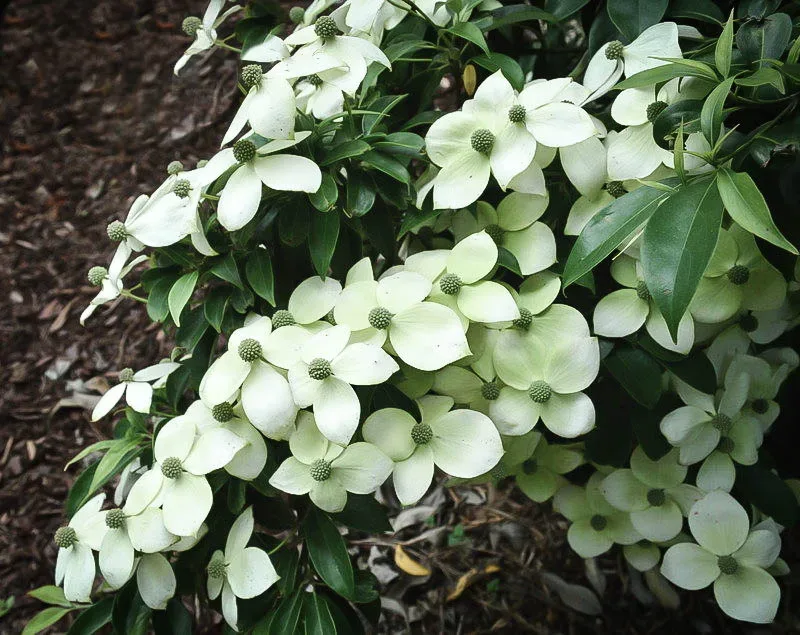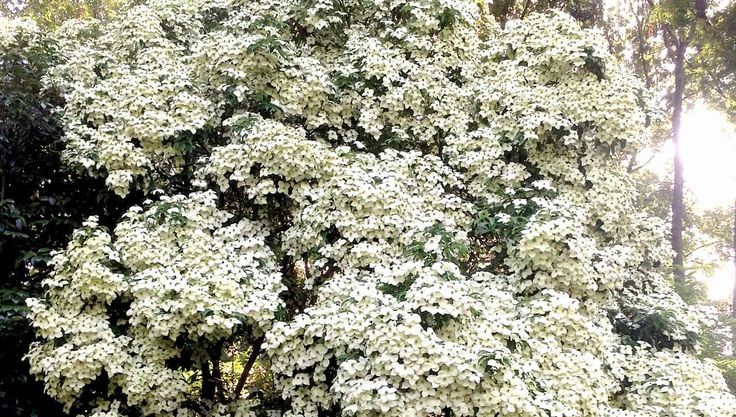
Flowering dogwood trees are hallmarks of Southern landscaping. One of our favorites is the Empress of China dogwood. It is an evergreen tree native to China that produces clusters of large, creamy white blooms in late spring and summer. The dazzling flowers turn into translucent ruby, strawberry-like fruits that songbirds enjoy eating. In the fall and winter, the foliage gradually turns a showy reddish-purple until new foliage pushes off the old leaves to emerge in spring. Empress of China is available in the Southern Living Plant Collection.
The best times to plant the tree are spring or fall. Growing at a slow to moderate rate up to 20 feet tall and wide, the Empress of China is an impressive accent tree worth considering for your garden. Its evergreen foliage creates privacy and shade near patios and porches.
Empress Of China Dogwood Care
The Empress of China can be grown in most of the South. This low-maintenance tree doesn’t require pruning and needs to be fertilized only once a year in early spring.
To plant, dig a hole three times the width of the tree’s original pot. Place the tree in the hole and backfill so that the root collar (where the roots meet the stem) sits one to two inches above the soil.
Light
Chinese evergreen dogwoods prefer more sunlight than some other dogwood species. To encourage a good bloom, plant it in a spot that gets direct sun but some protection from the hot afternoon sun.
Soil
The Empress of China dogwood prefers soil that is acidic, organically rich, and well-drained. Amend your soil with organic matter such as finely ground bark to improve drainage, or add compost to help retain moisture and enrich a sandy soil.
Water
Empress of China dogwoods need moderately moist soil, but they won’t do well in saturated soils. Water deeply when you first plant and continue to water regularly until the tree is established. Give your tree a drink in hot, dry weather, or it may drop some leaves. Your tree will require less water in winter.
To preserve moisture, spread 1 to 2 inches of mulch such as pine straw, bark mulch, or leaf litter, around the base of the tree but do not let the mulch touch the trunk.
Temperature And Humidity
While this tree can be grown in the Upper South, it is less likely to remain fully evergreen in winter north of USDA Plant Hardiness Zone 7.
Empress of China dogwood is better suited to humid than dry, arid climates.
Fertilizer
The Empress of China dogwood should only be fertilized once a year in spring. Dogwoods get the greatest benefit from annual fertilizing when they are young. Use a slow-release tree and shrub fertilizer, or add a fresh layer of compost around the tree.
Types Of Dogwood Trees
There are many species of dogwood native to North America, Africa, Asia, and Europe. These small understory trees are classified into tree and shrub forms. Dogwoods suitable for the South include:
- Chinese dogwood (Cornus kousa) is a popular Asian dogwood species with many cultivars. It grows in Zones 5-8 and flowers after its green leaves emerge.
- Flowering dogwood (Cornus florida) is the most widely recognized dogwood native to North America. It is the state tree and the state flower of Virginia.
- ‘Appalachian Spring’ (Cornus florida) is a cultivar of the native flowering dogwood, providing beauty year-round. It is suitable for Zone 5-9 and resistant to disease.
- ‘Cherokee Sunset’ (Cornus florida), another cultivar of the native flowering dogwood for Zone 5-9. It features pink-edged blooms and variegated foliage. It is heat-tolerant and has superior disease resistance.
Pruning
This low-maintenance tree does not require any pruning. Remove a stray or broken branch with a sharp pair of loppers or pruners at any time.
If you want to reshape the tree, wait until after flowering so you don’t lose the blooms. You will see less fruit on the tree wherever you remove the spent flowers.
Overwintering
Empress of China may not be reliably hardy in Zone 6 during a harsh winter. If you are expecting unusually cold temperatures, insulate the roots with a thick layer of mulch.
Common Pests & Plant Diseases
For a dogwood, Empress of China is considered very disease-resistant. The tree is not susceptible to the anthracnose that plagues many native dogwoods. The thick, leathery leaves are fairly resistant to mildew and insect damage as well.
How To Get Empress Of China To Bloom
Empress of China is a prolific bloomer, producing up to 150 blossoms per branch. White blooms of four petals surround a golden center, appearing after other flowering dogwoods have finished blooming.
Depending on how far north you live, the tree may not start blooming until early summer. Though dogwood grows in partial shade, it may not produce as many blooms. To encourage blooms, make sure to plant in a sunny location.
Failure to bloom might be caused by pruning the tree at the wrong time. Pruning in the spring before flowering sacrifices some flowers.
